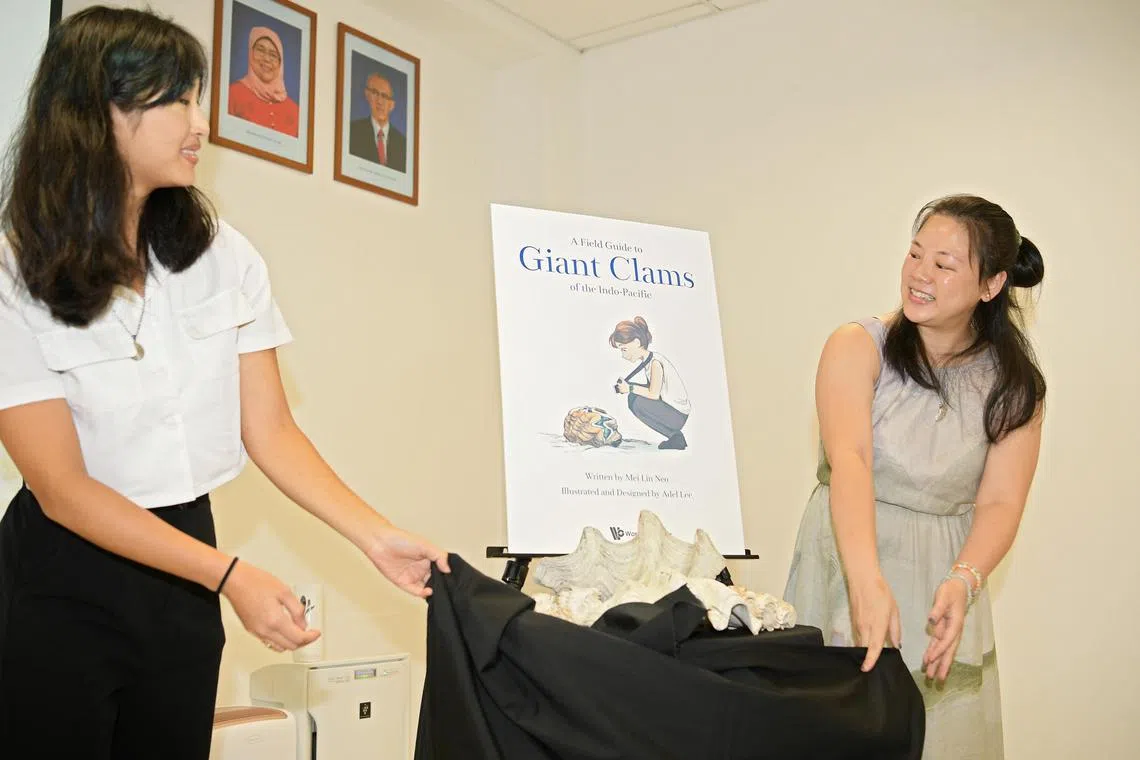Conservation of giant clams should factor in ecological roles and genetic data: Expert
Sign up now: Get ST's newsletters delivered to your inbox

Dr Neo Mei Lin with giant clams at the National Marine Laboratory on St John's Island..
ST PHOTO: NG SOR LUAN
Follow topic:
SINGAPORE - Examining the number of species has conventionally been the main way that conservation areas are prioritised.
But in the case of giant clams, factoring in their ecological roles and evolutionary history can help improve the biodiversity of conserved habitats, according to a book recently published by a giant clam expert based in Singapore.
“Traditionally, people assume that if we conserve an area with many species, we will essentially be able to protect the many different functions that all these species have in a certain habitat. But that’s still an assumption,” said Dr Neo Mei Lin, 36, a senior research fellow at the National University of Singapore’s Tropical Marine Science Institute.
Her book – A Field Guide To Giant Clams Of The Indo-Pacific – cites a study published in 2022 which showed that species richness alone cannot account for the biodiversity contributions derived from the phylogenetics and ecological roles of the giant clam species.
Biodiversity refers to the variety of life that can be found in the natural world, and how each species and microorganism works to maintain and support life in an ecosystem. When quantifying biodiversity, measurements could also include the variety of genes and ecological roles played by the individual species.
A phylogenetic analysis, which traces the evolutionary history of species by grouping closely related ones into subgroups in tree diagrams based on similarities and differences in their physical traits and genes, can help preserve biodiversity.
“If a species has a long evolutionary history, we will want to try and protect it. Otherwise, closely related species of giant clams could become extinct, resulting in the loss of certain ecological traits and functions that may not be found in the younger lineages,” Dr Neo explained.
The study, which was co-authored by Dr Neo, also gathered data for functional diversity by analysing how 14 traits of the giant clam species can contribute to an ecosystem.
Examples of these functions include filtering water and providing food and shelter for other animals in the ecosystem.
“A functionally diverse community would consist of species with highly unique traits that contribute numerous ecological roles. For instance, if there are 100 species in a community, but 50 per cent to 60 per cent of them play similar functions, then it does not mean that the area is more functionally diverse,” she said.
“The number of species in a community matters less if the individuals are all functionally unique, so much so that they can contribute more critical ecological functions.”
As an example, Dr Neo cited the true giant clam, which can grow up to 1.5m long.
“We realised that this particular species was very unique based on its traits. And one of the characteristics that drive this difference is its size. So, clearly, it has a special standing in the community compared with the other species,” she said.
Apart from including more biodiversity measurements in prioritising conservation areas for giant clams to thrive naturally, the book also highlights other methods, such as breeding giant clams in hatcheries before transplanting them in the wild. Successful cases can be found in the Philippines, the Federated States of Micronesia and Japan.

Dr Neo Mei Lin (right) and illustrator Adel Lee at the soft launch of their book A Field Guide To Giant Clams Of The Indo-Pacific.
ST PHOTO: NG SOR LUAN
But Dr Neo said more studies are needed to determine the impact of global warming and climate change on restocked giant clams.
“Restocking giant clams in areas where they used to occur is the easy part. But sustained monitoring is required to see how they may or may not be resilient to this new environment, especially if it has already changed due to other environmental factors. We will know the outcomes of restocking only after an attempt is made, because you can’t quite tell what the result will be until you put a giant clam there.”
So far, preliminary evidence suggests that ocean acidification from carbon emissions can single-handedly impact giant clams’ survival rates and shell growth.
More studies are needed to ascertain the effects of other factors, such as temperature, salinity and light availability, on giant clams, particularly the larvae, as they are likely to be vulnerable to increased acidity.
Apart from environmental threats, human factors like overfishing cause reduced wild giant clam populations, according to the book, which also touches on the cultural and socio-economic significance of these endangered marine bivalves.

